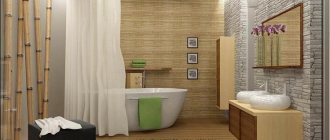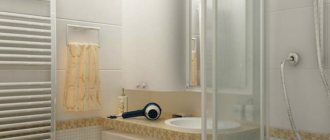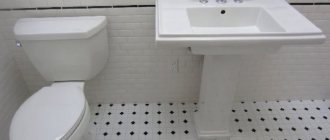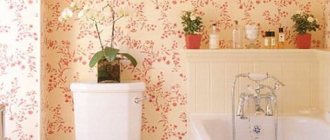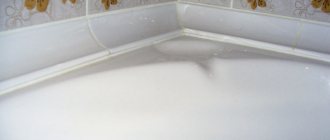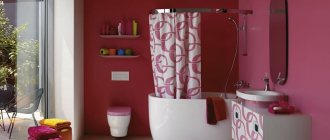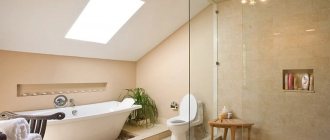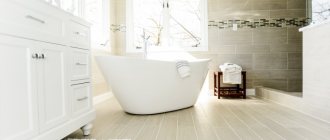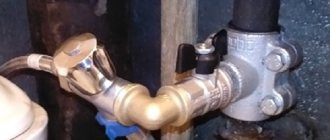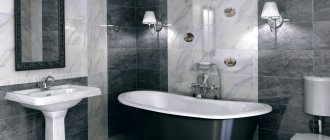Many people believe that an alternative to tiles is not needed in the bathroom - this is a material that meets the specific requirements for finishing this room. But instead of tiles, you can use other options - both inexpensive and premium.
Tile is not the only way to decorate a bathroom.
Types of wall decoration
How to replace tiles? An important characteristic for choosing a facing material for a bathroom is the product’s resistance to moisture. In addition to tiles, you can cover the wall with the following types of coatings:
- paint (oil, water-based, acrylic);
- panels made of plastic materials;
- linoleum;
- mosaic tiles;
- gypsum board sheets;
- wood panels;
- MDF panels;
- glass;
- plaster;
- porcelain stoneware materials;
- self-adhesive film;
- oilcloth.
All types of finishing materials differ in performance characteristics, shelf life, price, quality and other indicators. All this is an excellent alternative to tiles in the bathroom.
Linoleum and plastic laminate floors
Even beginners should not have any problems here. Attention, accuracy and adherence to existing technologies are the key to obtaining high-quality flooring. Plastic laminate is laid in exactly the same way as ordinary laminate. If there is a high risk of flooding in the bathroom, then increased attention should be paid to waterproofing issues. Study the marble bathtub at the link.
Linoleum in the bathroom
Dye
How to paint the walls in the bathroom? Covering the walls with a colorful coating is a relatively inexpensive and simple way to decorate (wall finishing options) in the bathroom.
For some, paint is associated with despondency and boredom, since previously it was oil materials that were used to decorate the walls of Khrushchev-era buildings. But technologies for the development of paint products are improving; water-based and acrylic paints have appeared, which are waterproof and durable.
The disadvantage of paint is that it can crack over time due to age, or from contact with hard and sharp objects.
If the person who decided to change the lining in the bathroom has artistic talent, then you can paint the walls using various patterns.
Applying paint to walls requires a lengthy preparatory phase. First you need to create a ground base, then putty the surface, only after that you can start painting the walls. During the filling process, it is important to make the wall as even and smooth as possible, otherwise the paint will quickly begin to crack, and all the unevenness and roughness will be visible on the wall.
The materials for the base must be of very high quality: repair specialists recommend purchasing polymer-based putty mixtures, as they evenly fill holes in the walls and level the surface.
Designers have developed several new types of paints that have become popular among apartment owners. The most fashionable trends in bathroom interiors are decorating walls with glossy paint (which will fit perfectly into a small room and increase the space), as well as a matte finish (recommended for large rooms).
Finishing bathroom tiles with more than just paint. You can use PVC panels, plasterboard for finishing, moisture-resistant laminate.
Modern types of paints are non-toxic; there is no need to ventilate the room for several days after application; it is enough to provide ventilation to the room while painting the walls.
How to replace tiles
Common people believe that since not all walls are in direct contact with water, it means that they can be covered with any type of cladding, including wooden lining, fiberboard panels and paper wallpaper. But steam is the same water, albeit in a different state of aggregation. And it harms wood just like any liquid. Repairing a bathroom without tiles is possible if you use 8 types of finishing materials listed below for the walls.
Classic enamel
The most cost-effective and easy-to-use alternative to bathroom tiles is enamel paint. They are used for cosmetic repairs, that is, a kind of renovation of the interior of sanitary premises. We recommend purchasing:
- standard alkyd compositions, for example, PF-115;
- safe acrylic enamels for mineral surfaces;
- durable and mechanically resistant urethane-alkyd or polyurethane mixtures.
All of the above varieties, after polymerization, form a waterproof film on the walls, inert to abrasion, steam, and aggressive chemicals.
Table 1 . Advantages and disadvantages of using enamels in bathrooms.
| № | pros | Minuses |
| 1. | Resistant to liquids and steam. | Careful preparation and leveling of the base is necessary, since the paint reveals every defect: roughness, cracks, etc. |
| 2. | Affordable – from 40 RUR/liter. And when choosing a high-quality composition, it is economical in consumption. | Over time, it begins to peel off, fade, and the white coating turns yellow. |
| 3. | Easy to care for. | When subjected to strong impacts or applied to deformable structures (plasterboard, SML), it cracks and peels off. |
| 4. | Easy to apply. | |
| 5. | Moderate resistance to shock loads. | |
| 6. | Can be used in “wet” areas. | |
| 7. | Restoration and renovation of the coating is possible without significant costs. | |
| 8. | Wide range of colors due to the use of special colors. | |
| 9. | Long service life when applied correctly - up to 10 years. |
If the room has poor ventilation and there is no window, then it is undesirable to use low-quality products or enamels with a strong odor, for example, NC. Toxic fumes will take a very long time to dissipate, at least 3-5 months. But it is easy to end up with severe poisoning or allergies with corresponding symptoms (headaches, nausea).
Water-dispersion paint
An excellent option for connoisseurs of environmental and budget solutions are dispersion painting compositions. They contain an acrylic binder, therefore they are safe to use and practically odorless. They can be used to cover plaster, wallpaper (fiberglass or paintable), drywall, decorative cladding made of cement or gypsum mixture, foam tiles, etc.
An important point: for the bathroom you can and should use latex high pressure paints from the interior series with fungicidal additives. Due to the content of synthetic rubber, this coating is not only resistant to water. It can be washed using mild household chemicals, as clearly stated on the labels. For example, “up to 5000 cycles,” etc. For best results, we recommend choosing formulations with a coverage rate of at least 95%.
Table 2 . Advantages and disadvantages of using dispersion paints in bathrooms.
| № | pros | Minuses |
| 1. | Moderate cost - from 60 rubles per liter. | Careful preparation of the substrate for painting is required. |
| 2. | Wide palette of shades - up to 7000 with computer tinting and more than 1000 with manual tinting. | It is not advisable to use it in the “wet area” around the bathroom or in the shower. |
| 3. | Resistant to steam and liquids. | Over time, the coating fades and requires renovation. |
| 4. | Environmentally friendly. | |
| 5. | Easy to apply. | |
| 6. | Durability – up to 15 years. | |
| 7. | Fast and easy update. |
Plastic panels
A very practical, although not very durable finishing option is PVC panels. Despite numerous assurances from marketers and salespeople, no other type of panel cladding is suitable for the bathroom. Only plastic finishing materials have the necessary resistance to water, steam and various liquids, including dyes and aggressive ones.
PVC panels are available in a wide range of designs: wood and tile, natural stone and fabric, leather and even metal. Collections with three-dimensional 3D patterns are interesting. All areas in the sanitary room, including “wet” ones, are allowed to be sheathed with plastic. It is especially convenient that the same material can be used to disguise pipes and cover open areas under the bathroom.
Installing wall coverings in restrooms is no different from working with them in other rooms. But we recommend using galvanized metal profiles for the frame part, or gluing the strips with special adhesives like Titan, Titebond, Bison MontageKit and the like.
Table 3 . Advantages and disadvantages of using dispersion paints in bathrooms.
| № | pros | Minuses |
| 1. | Acceptable cost - from 120 rubles/m2. | The surface is not very durable: with strong pressure, dents and cracks may form. |
| 2. | A good range of decors and shades. | You need a large set of components to install the panels or extra-strong mounting adhesive to fix the PVC to the wall. |
| 3. | Excellent water and chemical resistance. | Over time, light-colored panels may turn yellow. |
| 4. | Do-it-yourself installation is possible. | A large number of low-quality products in stores and markets. |
| 5. | Allowed for use in “wet” areas. | |
| 6. | Long service life - 10 years or more. |
We remind you once again: neither MDF panels, nor gypsum vinyl planks, nor tile-like slabs on a fiberboard base are suitable for bathrooms. An acceptable alternative is plexiglass or tempered glass slabs.
Decorative plaster
A spectacular bathroom without tiles is a reality. An invariably fashionable type of wall finishing is textured plaster with a volumetric effect to resemble concrete, craquelure, travertine, “Venetian” and other types of coatings. It is used both in natural and tinted form. After application, it can be coated with decorative paints, glazing compounds, and protective varnishes for stone.
Plaster mixtures in this series are most often sold as ready-made pastes. To apply them, deep knowledge of technology and some dexterity are required. To create a pattern, a special technique of working with a spatula or special textured rollers is used. Professional craftsmen manage to use decorative plaster alone to create three-dimensional paintings on the walls: castles, mountain landscapes and much more.
Table 4 . Pros and cons of using textured plaster in bathrooms.
| № | Advantages | Flaws |
| 1. | Moderate price - from 80 rub./kg. | Careful preparation of the base is required. |
| 2. | A wide range of shades and effects, from simple “bark beetle” to luxurious marble. | Not recommended for use in “wet areas” around the bathtub or shower area. |
| 3. | Resistant to steam and water. | Difficulties in removing limescale deposits and drops. |
| 4. | Safety. | After application and curing, it is advisable to paint the surface with protective compounds: glazing, coloring, varnish. |
| 5. | Possibility of restoration of damaged areas. | Difficult to apply with your own hands. |
| 6. | Durability – at least 10 years. |
Wallpaper
This method of decorating walls does not fall into the “cheap and cheerful” category. With good taste and some skill, you can create a truly royal interior. It’s easy to glue wallpaper yourself, and the number of decors and shades exceeds all reasonable limits.
However, there are limitations when it comes to the bathroom. Paper, natural and cellulose-based coverings are strictly contraindicated in sanitary premises. The best option is high-quality glass wallpaper from manufacturers such as Vitrulan, Tassoglas, etc. They are absolutely inert to water, household chemicals, shock and deforming loads. After pasting, it is recommended to coat them with water-dispersion paints. In relation to the bathroom, these should be washable compounds containing latex.
As an analogue, you can use vinyl and non-woven fabrics. However, there is a limitation on them: manufacturers do not recommend finishing “wet” areas with them, since the wallpaper can peel off or delaminate.
Table 5 . Advantages and disadvantages of using wallpaper in bathrooms.
| № | pros | Minuses |
| 1. | High level of environmental safety for glass wallpaper. | Lots of fakes and low quality products. |
| 2. | A rich range of colors and a good selection of decors. | A good, high-quality glue for gluing is required, as well as adherence to installation technology. |
| 3. | Easy installation. | For surface painting, you will need to purchase interior paints with fungicidal additives. |
| 4. | Moderate cost - from 60 rubles/m2. | |
| 5. | Restoration of damage is possible, as well as re-painting up to 10 times. | |
| 6. | Reinforcing effect. | |
| 7. | Long service life - at least 15 years. |
Artificial stone tiles
An interesting and striking analogue of traditional tiles is tiles for various surfaces, such as roughly processed concrete, unpolished natural stone, old brickwork, etc.
Made from:
- clinker or standard ceramic mixture;
- cement, lightweight concrete or gypsum;
- polymer cement composition containing acrylic, epoxy and other synthetic resins.
The material is interesting because it allows you to decorate the bathroom in styles such as loft, boho, rustic, chalet. The wide color palette is complemented by an equally rich assortment of various textures.
Tile or assembly adhesives are used for installation. The seams can be filled with grout or simply painted over to give the wall volume. Since there is a high level of humidity in the bathroom, experts recommend covering the surface with protective compounds: stone varnishes, acrylic enamels or latex dispersion paints. In our opinion, it is better to use the first two types of coatings, since they create a waterproof, dense film. It will make it much easier to clean surfaces from limescale and dirt, even with abrasive detergents.
Table 6 . Advantages and disadvantages of using decorative tiles in the bathroom.
| № | pros | Minuses |
| 1. | Moderate price - from 220 rubles/m2. | Careful preparation of the base is required. |
| 2. | Wide selection of textures and colors. | It is not advisable to use it in the “wet area” around the bathtub or in the shower, since it is very difficult to remove limescale, foam and other contaminants from the recesses and crevices. |
| 3. | Resistant to steam and non-abrasive household chemicals. | Low-quality products are sensitive to steam and water and may crumble. |
| 4. | Safety in operation. | |
| 5. | Easy installation. | |
| 6. | Durability – up to 15 years. | |
| 7. | Quick update and restoration of damage. |
Vinyl laminate
An unusual idea is to use an analogue of a floor board instead of tiles when decorating the walls. The result will be a very beautiful imitation of wooden panels, textiles or stone, which is not afraid of water, mold, mildew, or insects.
On the wall, the coating is assembled in the standard way for laminate, but with one important addition. Hardware must be used for a kind of safety fixation: pins or dowel-nails. The flush fastener is screwed or driven into the lock groove at an angle of approximately 30–45°.
When choosing decor, you must take into account the area of the room. The smaller the bathroom, the lighter the color should be.
Table 7 . Pros and cons of vinyl laminate flooring in bathrooms.
| № | Advantages | Flaws |
| 1. | Good selection of decors and shades. | It is necessary to follow the technology for preparing the base and assembling it. |
| 2. | Inert to steam, water and detergents. | Price – from 700 rub./m2. |
| 3. | High durability of the coating. | When using low-quality products, a strong chemical smell may remain in the room for a long time. |
| 4. | Restoration of minor damage is possible. | There may be some difficulties in cleaning the surface from limescale. |
| 5. | Long service life. |
A natural stone
Facings made of marble, onyx, travertine, granite and other types of stone are characterized by special beauty, brilliance and originality. Traditionally, they are used to decorate baths, saunas, and hammams. In private houses and apartments, this type of cladding is used to create bathrooms in antique, Moroccan, Japanese or Greek styles. Slabs made of natural stone are also suitable for decorating interiors to resemble Provence, rustic, or chalets.
Natural wall cladding is installed in the same way as standard ceramic tiles. But with a few significant differences:
- Special white super-strong adhesives are used, resistant to slipping and preventing color migration (coloring of the facing material).
- Particular attention is paid to the pattern, as well as to the areas around the pipes, in places where mirrors, cabinets, cabinets, etc. are installed. The slabs must be adjusted in such a way that the cuts are combined, partially or completely, as if moving from one element to another.
- Natural stone is difficult to work with, so it is best to entrust its installation to professional craftsmen.
Table 8 . Pros and cons of natural stone in bathrooms.
| № | Advantages | Flaws |
| 1. | Wide choice of colors - more than 7000 options. | High cost - from 1400 rubles/m2. |
| 2. | High strength of the coating, resistance to impact and deformation loads. | It is not advisable to clean the surface from dirt using aggressive household chemicals. |
| 3. | The resulting chips and small cracks can be restored. | Almost all types of natural stone have a porous structure, which is why water and dirt easily penetrate into the cladding structure. |
| 4. | Long service life with careful use. | Labor-intensive installation. |
Plastic panels
How can I replace tiles in the bathroom? Covering wall coverings with plastic panels is also a relatively inexpensive way to decorate a room. Installing such materials on walls can be very quick and easy.
The main advantage of plastic is that it can not only withstand moisture, but is also not subject to temperature changes that often occur in the bathroom.
If the room has uneven walls that cannot be made smooth even with plaster, or there is no time to level the wall surface, then laying plastic panels on the wall will help hide the unevenness.
The ceiling in the room can also be treated with this material.
The main disadvantage of plastic panels is that in the event of a fire, this material will instantly begin to melt. In addition, plastic is a very fragile structure that can easily be damaged during repairs, as well as during the operation of the coating.
Plastic can be cut with a regular hacksaw or saw, but do not forget that you need to protect your eyes with special glasses from chips. This material can be applied to the wall using glue or nails. It is important when driving a nail to remember that plastic sheets can easily be left with a dent from a hammer.
It is recommended to wash plastic walls with a soap solution, as chemical detergents can harm the wall covering.
Alternative to tiles for flooring
Tiles or porcelain stoneware are also used to finish the floor in the bathroom, but there are other alternative solutions, both economy and premium.
Floor enamel
An inexpensive way to finish a bathroom floor. This material is endowed with resistance to impacts, aggressive compounds and humidity. The enamel is available in a wide range of colors, plus any damage to the surface can be restored.
But if you buy low-quality material, the enamel will quickly crack and peel off. Also, the material is not suitable for heated floors.
Moisture-resistant laminate
A good alternative not only to tiles, but also to wooden floors. The main thing is to use a laminate for finishing, designed specifically for rooms with high humidity.
The advantages include: a wide selection of plank sizes and decor, resistance to wear, water, scratches, household chemicals and abrasion. And also easy installation, long service life and compatibility with underfloor heating systems.
Among the disadvantages are the high cost and the fact that there are many fakes on the market.
Self-leveling decorative floors
This finishing option can be called the brightest and most original. At the same time, self-leveling floors have a long service life, they are resistant to wear and various liquids, including caustic substances. And there’s no point in talking about the choice of colors and patterns; it all depends on the customer’s imagination.
Before considering this option, it is worth considering that such material is expensive plus installation; you cannot do without specialists. And restoration of damage, even partial, is impossible.
The choice of materials for finishing a bathroom is quite large, and you can always find a good alternative to tiles. If you need inexpensive repairs, then you should choose painting the walls and floors. Expensive methods include decorating a room with natural stone. But the service life of any cladding will depend on how carefully the base is prepared.
Oilcloth
If a very quick repair is required, then you can install the walls using a special coating - oilcloth. Oilcloth is a fabric that is impregnated during the production process with a composition that ensures complete waterproofness of the product.
Repair with such a coating is not long-term and can only serve as a temporary decoration. Oilcloth fabric is fragile, it quickly becomes covered with holes, and places appear to peel off from the wall covering.
To attach the oilcloth to the wall, you can even use simple PVA glue. If the oilcloth is made on a paper base, then you can attach it to the wall using a special glue for vinyl wallpaper for decoration.
Repair experts recommend using acrylic-based plaster for the preparatory coating of the surface. This is necessary in order to increase the adhesion force of the oilcloth to the wall.
Terrazzo
This is a trendy finishing option, very popular this year. The material is a mixture of glass, pebbles and small fractions of natural stone, therefore, with perfect polishing, an unusually beautiful surface is created. On the other hand, some may find this finishing option too colorful, so we recommend that you familiarize yourself with other options as well.
Self-adhesive film
One of the new options for tiling a bathroom is the use of self-adhesive film. The choice of color palette and design style is wide: there are glossy and matte types, there are self-adhesive films with and without patterns.
The most fashionable trend in interior design is covering walls with mirror film.
Advantages of this type of wall covering:
- low cost;
- quick installation of a wall surface;
- easy care;
- wide color palette;
- practicality.
This material is short-lived, but there are still types of films that can last up to ten years.
The main disadvantage of self-adhesive film is the formation of mold and fungal bacteria directly under it.
This material must be applied to smooth walls, which means you will have to spend money on purchasing a primer and putty materials. If the film is not applied to a bare wall, then leveling is not required; it is enough to stick it directly onto the old material.
Before applying the film to the wall, the surface must be degreased.
Comparison and selection of the best option
It is difficult to compare materials with different characteristics. But when choosing, you can consider the following points:
- If the main criterion is the low cost of the material, then plastic panels, acrylic paint or mineral plaster are the best choice for walls. You can put linoleum on the floor. Moreover, the materials will look good due to the variety of patterns and textures. They are also water resistant.
- When durability is important to the owner, natural stone is a good choice for wall coverings, and vinyl and laminate for floor coverings. However, such materials are quite expensive.
- If the aesthetic factor plays an important role, then you should choose natural stone or mosaic tiles for the wall, and self-leveling enamel for the floor.
Wallpaper and natural wood look beautiful in the interior, but they are not resistant enough to high humidity and require labor-intensive care. You should take into account the repairability of the coating and the ability to restore it yourself, without turning to specialists.
Mosaic
Mosaic laying of wall coverings is especially relevant in small rooms that have low ceilings. Small particles visually increase the height of the room, and such masonry looks very impressive.
Mosaic can be used as an additional element for decorating a bathroom, for example, by combining it with a colorful coating or plastic panels. You can make drawings from mosaics during cladding.
Laying this material is not at all easy, since the materials are very small, and covering the wall covering with this product requires skill and talent in artistic direction.
It is quite possible to decorate a wall using mosaics with your own hands, but it is better to turn to professionals so that the desired effect is achieved.
Installation of wall glass panels
Doing all the installation work is very simple; you can do it yourself. There are two installation methods: using screws or silicone glue.
- Fastening with screws . Glass wall panels can be secured with screws. They are installed in corners on four sides. The disadvantage of such fastening is in appearance. The screws are masked with special clips that are clearly visible.
- Fastening with glue . The appearance of such a panel will be beautiful and unusual, since the clips on it will not interfere. But when choosing this method of fastening, you should know that the wall on which the panel is hung must be absolutely flat.
In order to know the required size of the panel where the sockets and switches will be located, installation should occur only after the repair is completed.
Linoleum
If the wall covering is made using linoleum, then you need to remove the old material in advance and prepare the wall using a primer and putty mixture. After careful processing and leveling of the surface, you can begin gluing the linoleum.
When the material is evenly and tightly applied to the wall covering, there is a high probability that mold and fungal bacteria will not appear between the wall and the linoleum.
In addition, linoleum can easily serve for about ten years, despite exposure to water and temperature changes.
Special linoleum is produced for bathrooms, which is durable, moisture-resistant, and flexible. There are many colors of the material, which are designed not only in the form of plain coatings, but also in products with patterns.
Lining
There are several types of lining: wooden, plastic, lining made from MDF panels.
A common type is plastic lining, which is moisture resistant, inexpensive and relatively durable.
When choosing lining for decorating a wall surface in a bathroom, it is recommended to purchase products made from MDF sheets. This is the best and most practical material among all other types of linings.
The main advantages of lining made from MDF panels:
- simplicity of facing work;
- aesthetic appearance of the room;
- ease of care;
- high degree of sound insulation;
- resistance to light exposure;
- resistance to temperature changes.
There are several tricks for visually reducing or enlarging a room using a product such as lining.
If the bathroom is small in size, then you can increase the wall covering in this room by vertically laying the panels. As a result, the ceiling in the room will become visually high. For a large room, on the contrary, horizontal installation is relevant.
A very fashionable trend in bathroom design is eco-style, for which you can use wooden lining. Construction stores sell special wood for processing wall surfaces in bathrooms. Wooden material does not rot due to the fact that the wood is strongly dried during the production process and then impregnated with a special solution that ensures the moisture resistance of the product.
Despite the fact that wooden panels are treated against moisture, it is recommended to additionally coat them with wax or a special varnish that protects the surface of the product from water exposure.
The advantage of the lining is that insulation can be laid between it and the wall. This solution is relevant for private houses where the bathroom is located in the attached part.
Coloring
Using paint is the most economical and simplified way to change the interior of a bathroom. This decoration method is a suitable option for rooms decorated in Scandinavian, loft or Provence style.
Walls covered with matte paint go well with classic or rustic styles.
Before painting the walls, the surface must be prepared for work. The plane is carefully leveled, treated with several layers of primer, and then painted. This will help avoid the appearance of streaks, smudges and unevenness. You can apply the desired pattern on top of the base layer, which will give the room a bright and stylish appearance. When applying painting, special stencils will be useful. If necessary, the design can be easily changed with a new color.
Paint allows you to create an original and unique bathroom design
One of the disadvantages of coloring is the need for regular care. The walls must be constantly cleaned of accumulated dirt and dust. A specialized chemical composition is suitable as a cleaning agent.
It is recommended to use latex-based paint as a consumable, which is resistant to liquids and dirt.
Bright bathroom interior created by painting surfaces in contrasting colors
GVL or moisture-resistant plasterboard in the bathroom
Typically, plasterboard sheets are used to make the base for other types of wall coverings in the bathroom. Therefore, it is not recommended to use plasterboard sheets in their pure form - experts have not yet developed design options for this coating.
Other covering materials are usually applied to drywall - ceramic tiles, MDF panels, paint, etc.
Despite the fact that plasterboard sheets have moisture-resistant properties, it is not recommended to expose this material to direct exposure to water.
Installing plasterboard panels is not too difficult and inexpensive.
Most often, a supporting frame is used to install plasterboard panels. You can make a frame from wooden or metal bars.
The sheets are attached to the base using self-tapping screws, glue or liquid nails. After laying the plasterboard sheets on the wall covering and leveling them, you need to treat the joints and seams with a hermetic material.
Waterproof or liquid wallpaper
The use of wallpaper instead of tiles, one might say, is a rather unusual measure, although effective. Bathroom walls decorated with liquid or moisture-resistant wallpaper look attractive. However, it is best to combine this material with PVC panels. Vinyl or fiberglass wallpaper is primed using a moisture-resistant mixture with antifungal components. For better sealing, the joints are treated with a silicone compound. Liquid products are simply applied to the wall with a spatula. They can be wiped with a damp cloth and soapy water.
Finishing with liquid wallpaper
Glass blocks
The use of glass blocks in the decorative design of bathrooms is again becoming a fashionable trend in design. Glass blocks can not only decorate a bathroom wall, but also create a partition for a shower stall.
Caring for such products is quite simple, and they themselves do not get very dirty. Glass block structures combine well with ceramic tiles, which will help refresh the room if you don’t want to completely remove the tiles from the walls in the room.
Another advantage of glass blocks is the high light transmission of these products, which makes the bathroom much lighter and more comfortable.
The disadvantage of glass blocks is that they can be scratched very easily, and this will be very visible on the surface of the wall.
It’s very easy to decorate a bathroom with your own hands using glass blocks using cement-based glue or special modular systems that are sold in many hardware stores.
How to choose?
It will be necessary to highlight the fact that frame models are more popular because they have better indicators of stability and practicality when used.
In these options, transparent or frosted glass is most often used, which are perfect for the modern interior of the room.
If you like a bathroom with glass, then when choosing a material, pay special attention to strength and reliability, because the safety and service life of this popular material will depend on this.
Porcelain tiles
This is a very expensive, but at the same time, high-quality and durable type of wall covering for the bathroom. The advantage of this material is that it is resistant to moisture and temperature changes, as well as wear-resistant.
Porcelain tiles will never fade or conduct current. This is a very durable material that is highly hygienic. The occurrence of fungal bacteria and mold on the surface of porcelain stoneware is virtually eliminated.
Porcelain stoneware products are stronger than tiles due to the fact that the structure of this product is less porous. Under the porcelain stoneware design, you can hide wiring, as well as water and sewer lines.
The disadvantage of this material, compared to ceramic tiles, is that so far the colors of porcelain stoneware products are presented on the construction market in limited quantities.
Installing porcelain tiles is not much different from the process of installing ceramic tiles, so you can do this work yourself. To do this, you need to purchase tile adhesive or liquid nails, which more firmly hold heavy structures such as porcelain tiles.
Decorative plaster
A non-standard solution for decorating walls in a bathroom is to apply decorative plaster to the wall covering.
This type of room installation product has a number of advantages:
- High level of moisture permeability.
When purchasing at a hardware store, you need to clarify that the product is being purchased to decorate the walls in the bathroom. In this case, the seller will present all materials that are moisture resistant.
- Vapor permeability of the material.
This characteristic helps maintain the indoor climate by absorbing vapors at high air humidity. If the room is dry, the plaster will release moisture back.
- Easy care.
Despite the fragile appearance of the wall covering, it is very easy to care for. Due to the high degree of moisture resistance, the decorative surface does not collapse over time.
Despite all the advantages of this type of product for decorating bathroom walls, it is recommended not to place textured plaster in areas that are subject to direct contact with water. This is because the cavities in the textured surface fill over time, but the water does not flow back out. This does not create the best appearance for the bathroom.
If the owner of the apartment really wants the plaster to be in a place where it is strongly exposed to water, then he can increase the water-repellent properties of the plaster by applying a special varnish or wax. You can purchase these materials at construction stores.
